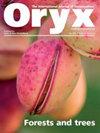恢复之路:对极度濒危的巴厘岛八哥的保护管理显示出成功的迹象
IF 2.1
3区 环境科学与生态学
Q2 BIODIVERSITY CONSERVATION
引用次数: 0
摘要
长期以来,巴厘岛八头猴遭受了大量的诱捕,导致其在野外濒临灭绝,并被世界自然保护联盟列为极度濒危物种红色名录。直到最近,巴厘岛巴拉特国家公园几十年来的保护繁殖、放生和放生后的管理都未能确保一个可行的野生种群。然而,在过去的十年中,数量增加,扩展到国家公园的新区域和更远的地方,并且在人工和自然筑巢地点成功繁殖。这些最近的成功与国家公园当局在方法上的改变有关,从把精力集中在物种的最后避难所(一个免受诱捕但可能不理想的栖息地的地区)到人类主导的景观,通过国家公园的主要道路。巴厘岛的mynas倾向于喜欢广泛的短草覆盖和开放的树冠地区,避开茂密的林地。农田和种植园等人为景观可能模仿了该物种的原始草原栖息地,但在没有自然洞穴的这些地区,巢箱的供应可能至关重要。八头蛇数量和范围增加的另一个潜在因素是一项让当地人参与该物种商业繁殖的计划,从而降低其市场价格,并与社区合作减少捕获压力。我们鼓励在国家公园内继续实施这一管理策略,并将其进一步扩展到邻近的旅游区,这些旅游区似乎具有对八哥友好的社会生态条件。本文章由计算机程序翻译,如有差异,请以英文原文为准。
The road to recovery: conservation management for the Critically Endangered Bali myna shows signs of success
The Bali myna Leucopsar rothschildi has long suffered heavy trapping, leading to its near extinction in the wild and categorization as Critically Endangered on the IUCN Red List. Decades of conservation breeding, release of birds and post-release management at Bali Barat National Park have, until recently, failed to secure a viable wild population. However, over the past decade, population increases, expansion into new areas of the National Park and beyond, and successful breeding in both artificial and natural nest sites have occurred. These recent successes are associated with a change in approach by the National Park authority from concentrating efforts on the last refugium of the species (an area protected from trapping but with potentially suboptimal habitat) and towards the human-dominated landscapes around the main road through the National Park. Bali mynas tended to favour areas with extensive shorter grass cover and open canopies and to shun denser woodland. Anthropogenic landscapes such as farmland and plantations presumably mimic the original savannah habitat of the species, but nestbox provision has probably been crucial in these areas in the absence of natural cavities. A potential further factor in the increases in myna numbers and range has been a scheme involving local people in commercial breeding of the species, thereby reducing its market price, and working with communities to reduce trapping pressure. We encourage continuing operation of this management strategy inside the National Park and its further extension into adjacent tourist areas, which appear to have myna-friendly socio-ecological conditions.
求助全文
通过发布文献求助,成功后即可免费获取论文全文。
去求助
来源期刊

Oryx
环境科学-生态学
CiteScore
5.30
自引率
7.40%
发文量
150
审稿时长
18-36 weeks
期刊介绍:
ORYX—THE INTERNATIONAL JOURNAL OF CONSERVATION, a quarterly journal from Fauna & Flora International, publishes research on biodiversity conservation, conservation policy and sustainable use, and the interactions of these matters with social, economic and political issues. The journal has a particular interest in material with the potential to improve conservation management and practice. Explore the map for details of published articles.
 求助内容:
求助内容: 应助结果提醒方式:
应助结果提醒方式:


